BSc (Hons) Business Management BMP4005: Big Data Analysis Report
VerifiedAdded on 2023/06/07
|8
|1896
|184
Report
AI Summary
This report, prepared for a BSc (Hons) Business Management course (BMP4005), delves into the realm of big data and its significance in the business world. The introduction defines big data and highlights its crucial role in modern business operations. It examines the characteristics of big data, including volume, value, variety, velocity, and veracity (the 5Vs), and discusses the challenges associated with big data analytics, such as data security, data integration, and the need for skilled professionals. The report then explores various techniques used to analyze big data, including machine learning, classification tree analysis, association rule learning, and social network analysis. Furthermore, it illustrates how big data technology supports businesses, offering examples related to data safety, revenue enhancement, and improved consumer communication. The conclusion summarizes the key findings, emphasizing the importance of big data for organizations. The report also includes a poster and references relevant academic sources.
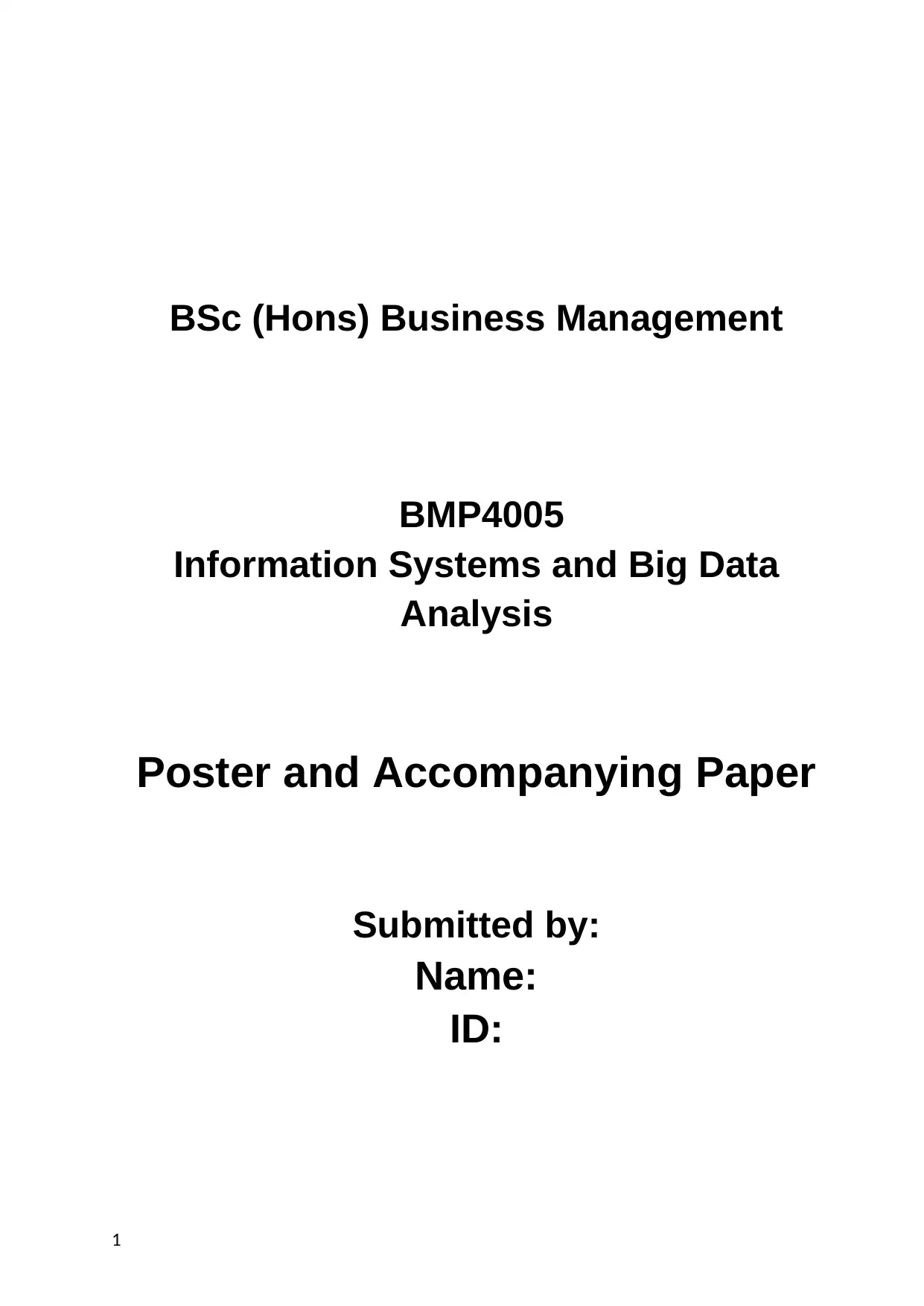
BSc (Hons) Business Management
BMP4005
Information Systems and Big Data
Analysis
Poster and Accompanying Paper
Submitted by:
Name:
ID:
1
BMP4005
Information Systems and Big Data
Analysis
Poster and Accompanying Paper
Submitted by:
Name:
ID:
1
Paraphrase This Document
Need a fresh take? Get an instant paraphrase of this document with our AI Paraphraser
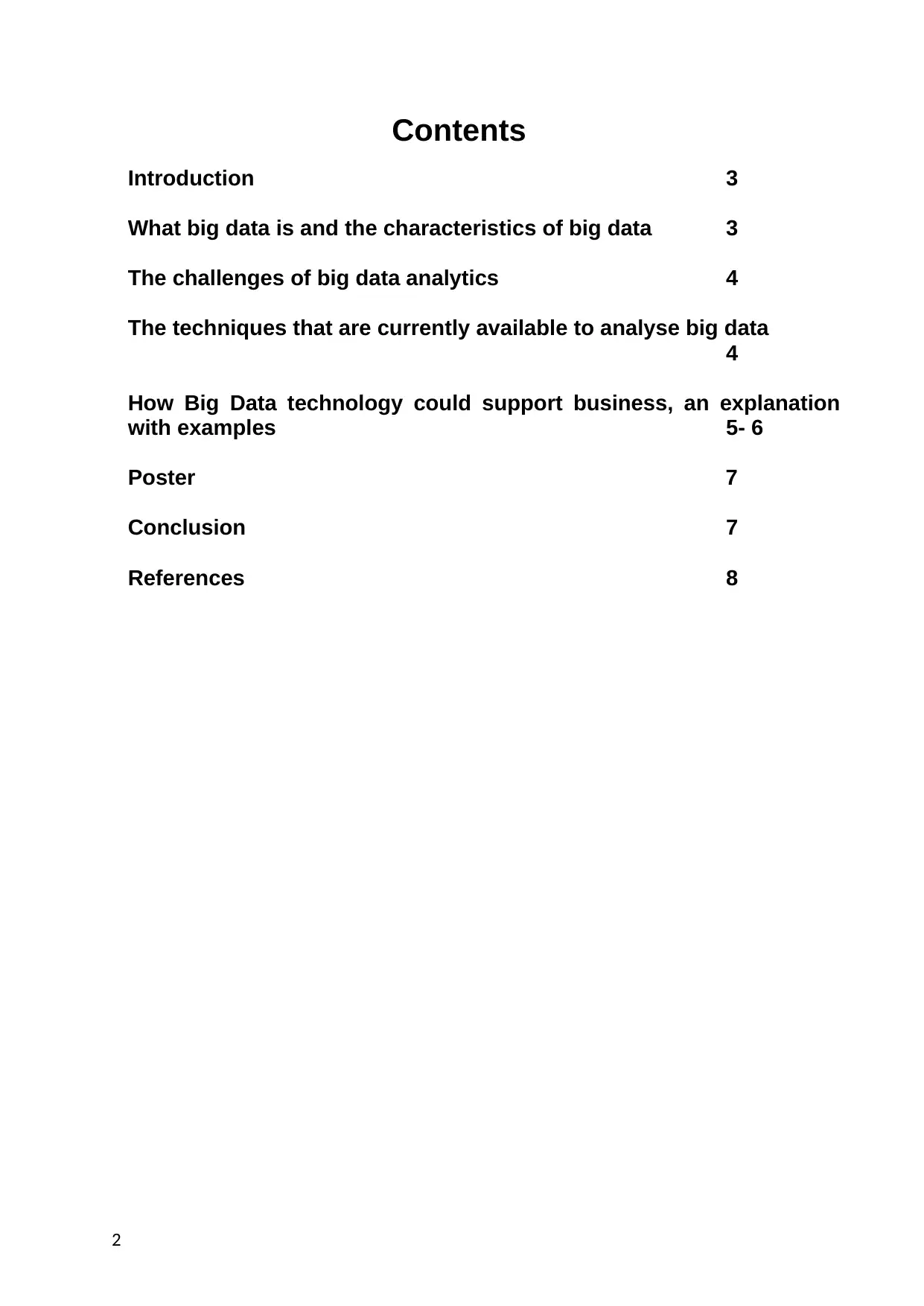
Contents
Introduction 3
What big data is and the characteristics of big data 3
The challenges of big data analytics 4
The techniques that are currently available to analyse big data
4
How Big Data technology could support business, an explanation
with examples 5- 6
Poster 7
Conclusion 7
References 8
2
Introduction 3
What big data is and the characteristics of big data 3
The challenges of big data analytics 4
The techniques that are currently available to analyse big data
4
How Big Data technology could support business, an explanation
with examples 5- 6
Poster 7
Conclusion 7
References 8
2
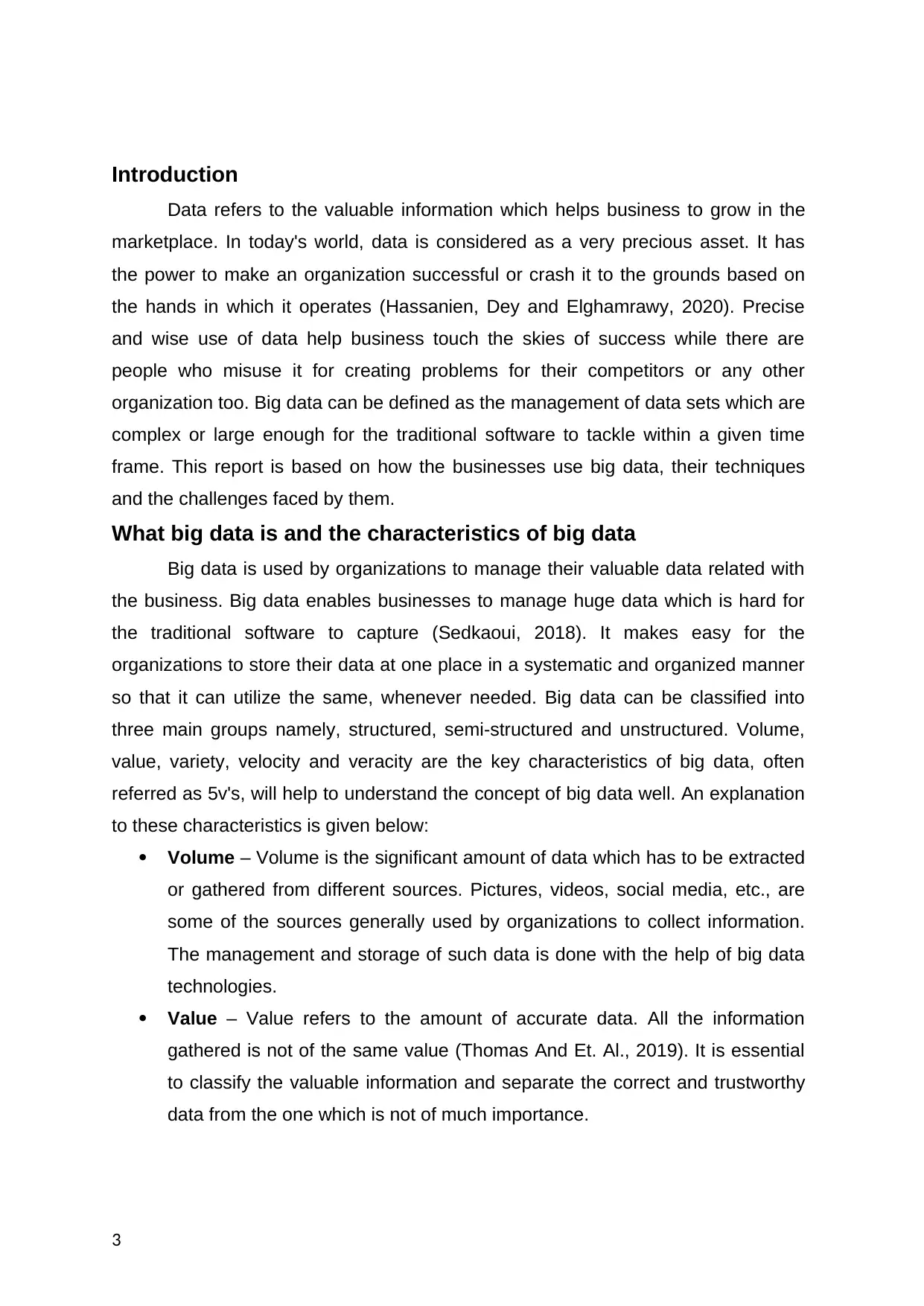
Introduction
Data refers to the valuable information which helps business to grow in the
marketplace. In today's world, data is considered as a very precious asset. It has
the power to make an organization successful or crash it to the grounds based on
the hands in which it operates (Hassanien, Dey and Elghamrawy, 2020). Precise
and wise use of data help business touch the skies of success while there are
people who misuse it for creating problems for their competitors or any other
organization too. Big data can be defined as the management of data sets which are
complex or large enough for the traditional software to tackle within a given time
frame. This report is based on how the businesses use big data, their techniques
and the challenges faced by them.
What big data is and the characteristics of big data
Big data is used by organizations to manage their valuable data related with
the business. Big data enables businesses to manage huge data which is hard for
the traditional software to capture (Sedkaoui, 2018). It makes easy for the
organizations to store their data at one place in a systematic and organized manner
so that it can utilize the same, whenever needed. Big data can be classified into
three main groups namely, structured, semi-structured and unstructured. Volume,
value, variety, velocity and veracity are the key characteristics of big data, often
referred as 5v's, will help to understand the concept of big data well. An explanation
to these characteristics is given below:
Volume – Volume is the significant amount of data which has to be extracted
or gathered from different sources. Pictures, videos, social media, etc., are
some of the sources generally used by organizations to collect information.
The management and storage of such data is done with the help of big data
technologies.
Value – Value refers to the amount of accurate data. All the information
gathered is not of the same value (Thomas And Et. Al., 2019). It is essential
to classify the valuable information and separate the correct and trustworthy
data from the one which is not of much importance.
3
Data refers to the valuable information which helps business to grow in the
marketplace. In today's world, data is considered as a very precious asset. It has
the power to make an organization successful or crash it to the grounds based on
the hands in which it operates (Hassanien, Dey and Elghamrawy, 2020). Precise
and wise use of data help business touch the skies of success while there are
people who misuse it for creating problems for their competitors or any other
organization too. Big data can be defined as the management of data sets which are
complex or large enough for the traditional software to tackle within a given time
frame. This report is based on how the businesses use big data, their techniques
and the challenges faced by them.
What big data is and the characteristics of big data
Big data is used by organizations to manage their valuable data related with
the business. Big data enables businesses to manage huge data which is hard for
the traditional software to capture (Sedkaoui, 2018). It makes easy for the
organizations to store their data at one place in a systematic and organized manner
so that it can utilize the same, whenever needed. Big data can be classified into
three main groups namely, structured, semi-structured and unstructured. Volume,
value, variety, velocity and veracity are the key characteristics of big data, often
referred as 5v's, will help to understand the concept of big data well. An explanation
to these characteristics is given below:
Volume – Volume is the significant amount of data which has to be extracted
or gathered from different sources. Pictures, videos, social media, etc., are
some of the sources generally used by organizations to collect information.
The management and storage of such data is done with the help of big data
technologies.
Value – Value refers to the amount of accurate data. All the information
gathered is not of the same value (Thomas And Et. Al., 2019). It is essential
to classify the valuable information and separate the correct and trustworthy
data from the one which is not of much importance.
3
⊘ This is a preview!⊘
Do you want full access?
Subscribe today to unlock all pages.

Trusted by 1+ million students worldwide
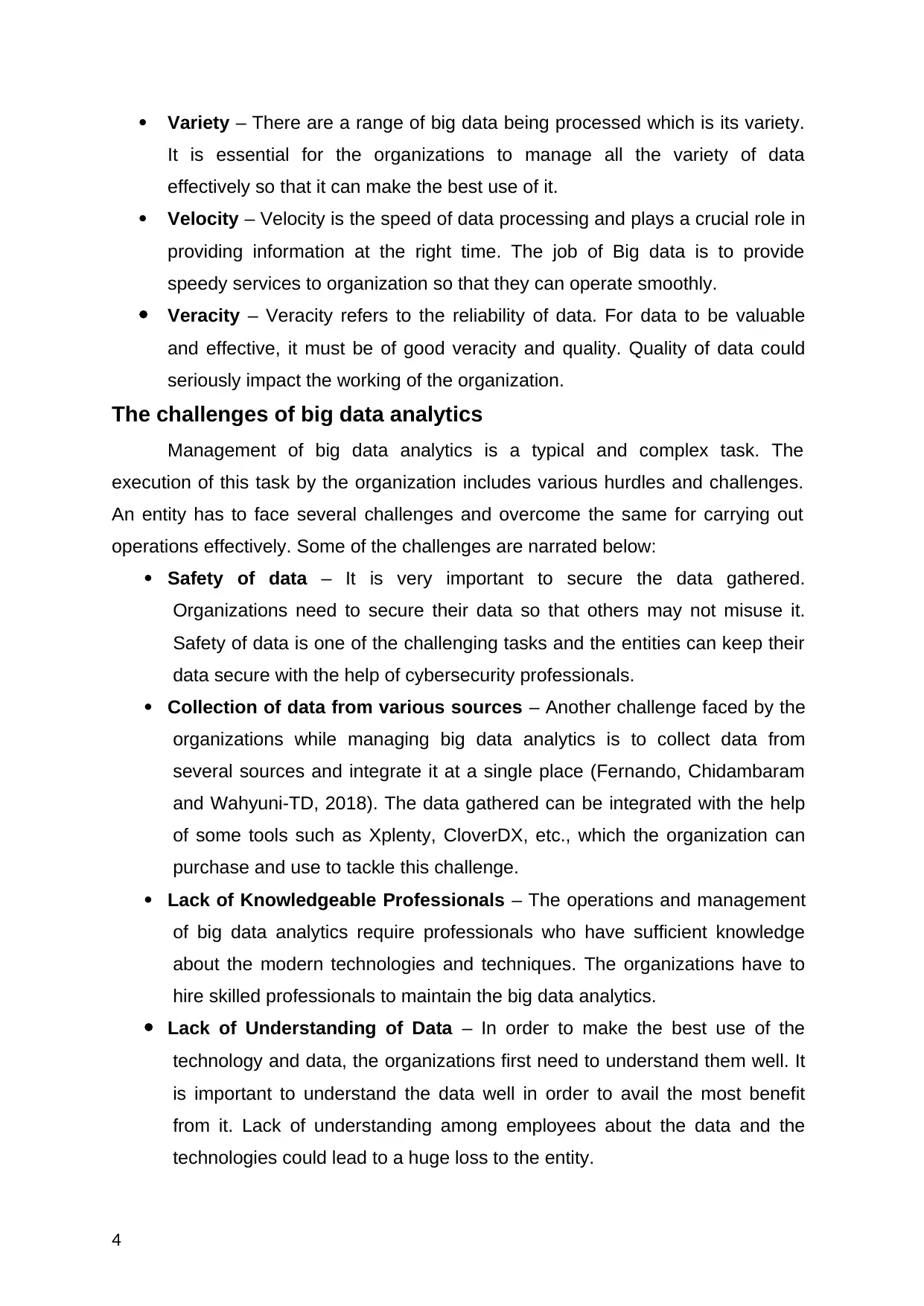
Variety – There are a range of big data being processed which is its variety.
It is essential for the organizations to manage all the variety of data
effectively so that it can make the best use of it.
Velocity – Velocity is the speed of data processing and plays a crucial role in
providing information at the right time. The job of Big data is to provide
speedy services to organization so that they can operate smoothly.
Veracity – Veracity refers to the reliability of data. For data to be valuable
and effective, it must be of good veracity and quality. Quality of data could
seriously impact the working of the organization.
The challenges of big data analytics
Management of big data analytics is a typical and complex task. The
execution of this task by the organization includes various hurdles and challenges.
An entity has to face several challenges and overcome the same for carrying out
operations effectively. Some of the challenges are narrated below:
Safety of data – It is very important to secure the data gathered.
Organizations need to secure their data so that others may not misuse it.
Safety of data is one of the challenging tasks and the entities can keep their
data secure with the help of cybersecurity professionals.
Collection of data from various sources – Another challenge faced by the
organizations while managing big data analytics is to collect data from
several sources and integrate it at a single place (Fernando, Chidambaram
and Wahyuni-TD, 2018). The data gathered can be integrated with the help
of some tools such as Xplenty, CloverDX, etc., which the organization can
purchase and use to tackle this challenge.
Lack of Knowledgeable Professionals – The operations and management
of big data analytics require professionals who have sufficient knowledge
about the modern technologies and techniques. The organizations have to
hire skilled professionals to maintain the big data analytics.
Lack of Understanding of Data – In order to make the best use of the
technology and data, the organizations first need to understand them well. It
is important to understand the data well in order to avail the most benefit
from it. Lack of understanding among employees about the data and the
technologies could lead to a huge loss to the entity.
4
It is essential for the organizations to manage all the variety of data
effectively so that it can make the best use of it.
Velocity – Velocity is the speed of data processing and plays a crucial role in
providing information at the right time. The job of Big data is to provide
speedy services to organization so that they can operate smoothly.
Veracity – Veracity refers to the reliability of data. For data to be valuable
and effective, it must be of good veracity and quality. Quality of data could
seriously impact the working of the organization.
The challenges of big data analytics
Management of big data analytics is a typical and complex task. The
execution of this task by the organization includes various hurdles and challenges.
An entity has to face several challenges and overcome the same for carrying out
operations effectively. Some of the challenges are narrated below:
Safety of data – It is very important to secure the data gathered.
Organizations need to secure their data so that others may not misuse it.
Safety of data is one of the challenging tasks and the entities can keep their
data secure with the help of cybersecurity professionals.
Collection of data from various sources – Another challenge faced by the
organizations while managing big data analytics is to collect data from
several sources and integrate it at a single place (Fernando, Chidambaram
and Wahyuni-TD, 2018). The data gathered can be integrated with the help
of some tools such as Xplenty, CloverDX, etc., which the organization can
purchase and use to tackle this challenge.
Lack of Knowledgeable Professionals – The operations and management
of big data analytics require professionals who have sufficient knowledge
about the modern technologies and techniques. The organizations have to
hire skilled professionals to maintain the big data analytics.
Lack of Understanding of Data – In order to make the best use of the
technology and data, the organizations first need to understand them well. It
is important to understand the data well in order to avail the most benefit
from it. Lack of understanding among employees about the data and the
technologies could lead to a huge loss to the entity.
4
Paraphrase This Document
Need a fresh take? Get an instant paraphrase of this document with our AI Paraphraser
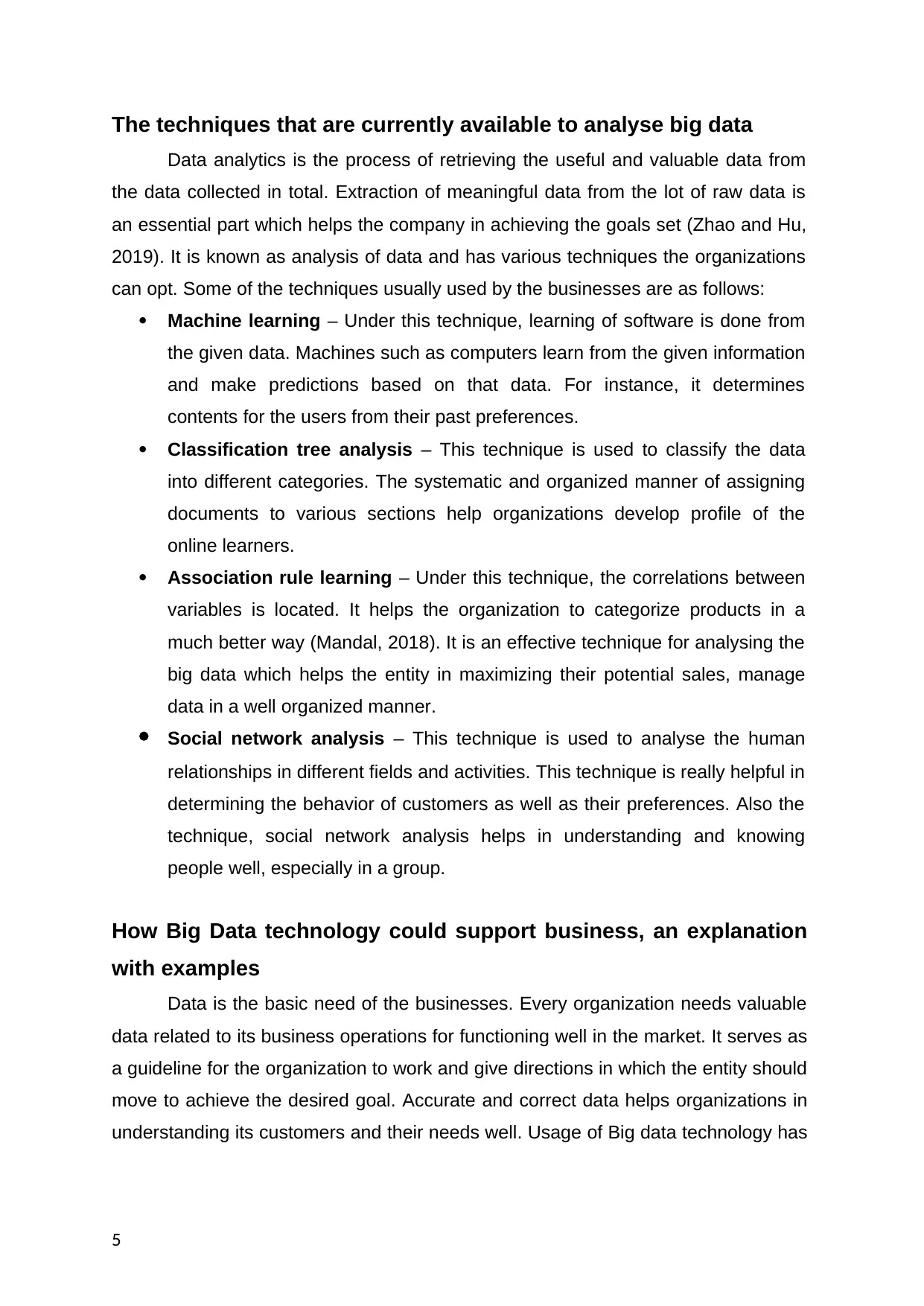
The techniques that are currently available to analyse big data
Data analytics is the process of retrieving the useful and valuable data from
the data collected in total. Extraction of meaningful data from the lot of raw data is
an essential part which helps the company in achieving the goals set (Zhao and Hu,
2019). It is known as analysis of data and has various techniques the organizations
can opt. Some of the techniques usually used by the businesses are as follows:
Machine learning – Under this technique, learning of software is done from
the given data. Machines such as computers learn from the given information
and make predictions based on that data. For instance, it determines
contents for the users from their past preferences.
Classification tree analysis – This technique is used to classify the data
into different categories. The systematic and organized manner of assigning
documents to various sections help organizations develop profile of the
online learners.
Association rule learning – Under this technique, the correlations between
variables is located. It helps the organization to categorize products in a
much better way (Mandal, 2018). It is an effective technique for analysing the
big data which helps the entity in maximizing their potential sales, manage
data in a well organized manner.
Social network analysis – This technique is used to analyse the human
relationships in different fields and activities. This technique is really helpful in
determining the behavior of customers as well as their preferences. Also the
technique, social network analysis helps in understanding and knowing
people well, especially in a group.
How Big Data technology could support business, an explanation
with examples
Data is the basic need of the businesses. Every organization needs valuable
data related to its business operations for functioning well in the market. It serves as
a guideline for the organization to work and give directions in which the entity should
move to achieve the desired goal. Accurate and correct data helps organizations in
understanding its customers and their needs well. Usage of Big data technology has
5
Data analytics is the process of retrieving the useful and valuable data from
the data collected in total. Extraction of meaningful data from the lot of raw data is
an essential part which helps the company in achieving the goals set (Zhao and Hu,
2019). It is known as analysis of data and has various techniques the organizations
can opt. Some of the techniques usually used by the businesses are as follows:
Machine learning – Under this technique, learning of software is done from
the given data. Machines such as computers learn from the given information
and make predictions based on that data. For instance, it determines
contents for the users from their past preferences.
Classification tree analysis – This technique is used to classify the data
into different categories. The systematic and organized manner of assigning
documents to various sections help organizations develop profile of the
online learners.
Association rule learning – Under this technique, the correlations between
variables is located. It helps the organization to categorize products in a
much better way (Mandal, 2018). It is an effective technique for analysing the
big data which helps the entity in maximizing their potential sales, manage
data in a well organized manner.
Social network analysis – This technique is used to analyse the human
relationships in different fields and activities. This technique is really helpful in
determining the behavior of customers as well as their preferences. Also the
technique, social network analysis helps in understanding and knowing
people well, especially in a group.
How Big Data technology could support business, an explanation
with examples
Data is the basic need of the businesses. Every organization needs valuable
data related to its business operations for functioning well in the market. It serves as
a guideline for the organization to work and give directions in which the entity should
move to achieve the desired goal. Accurate and correct data helps organizations in
understanding its customers and their needs well. Usage of Big data technology has
5
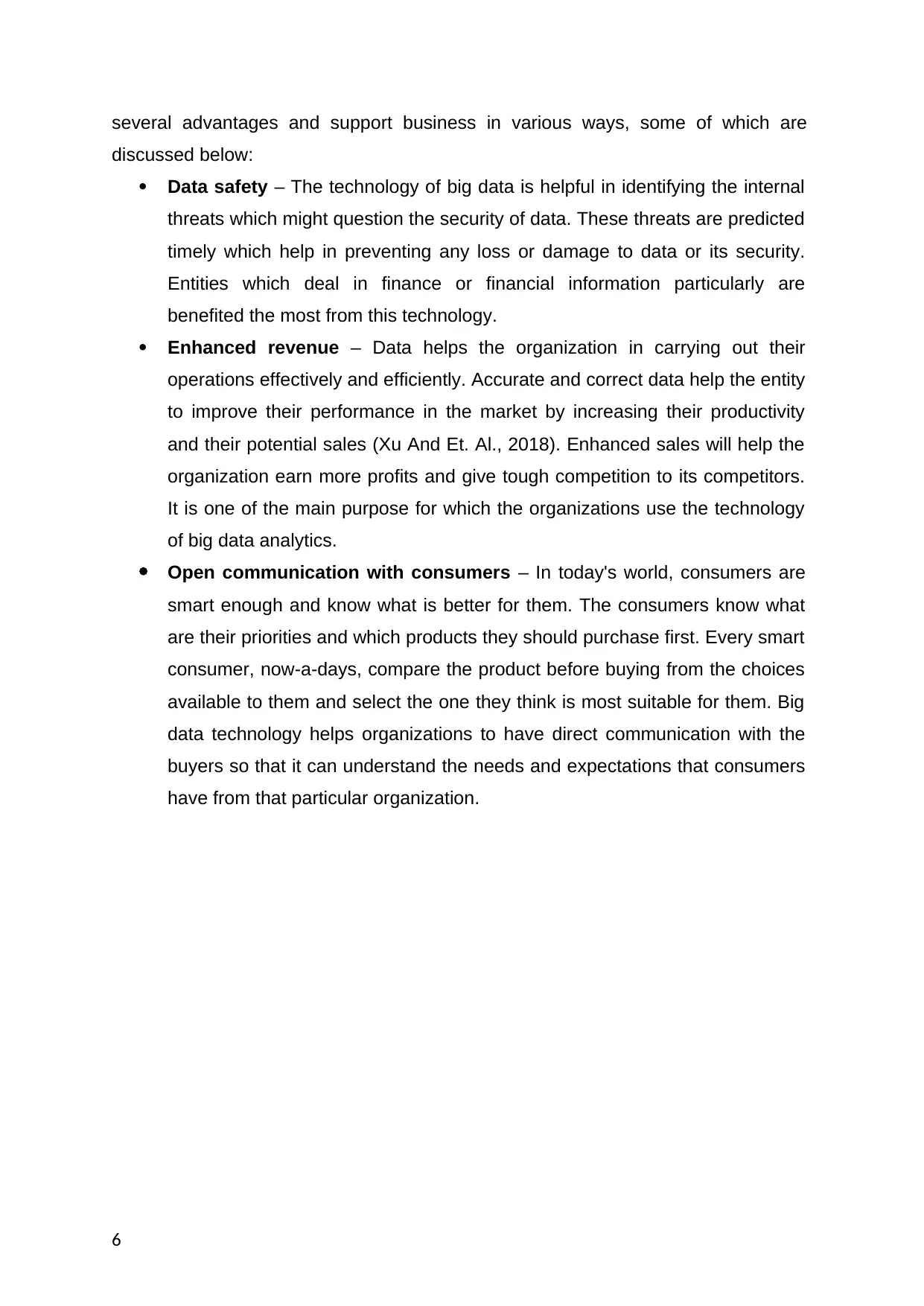
several advantages and support business in various ways, some of which are
discussed below:
Data safety – The technology of big data is helpful in identifying the internal
threats which might question the security of data. These threats are predicted
timely which help in preventing any loss or damage to data or its security.
Entities which deal in finance or financial information particularly are
benefited the most from this technology.
Enhanced revenue – Data helps the organization in carrying out their
operations effectively and efficiently. Accurate and correct data help the entity
to improve their performance in the market by increasing their productivity
and their potential sales (Xu And Et. Al., 2018). Enhanced sales will help the
organization earn more profits and give tough competition to its competitors.
It is one of the main purpose for which the organizations use the technology
of big data analytics.
Open communication with consumers – In today's world, consumers are
smart enough and know what is better for them. The consumers know what
are their priorities and which products they should purchase first. Every smart
consumer, now-a-days, compare the product before buying from the choices
available to them and select the one they think is most suitable for them. Big
data technology helps organizations to have direct communication with the
buyers so that it can understand the needs and expectations that consumers
have from that particular organization.
6
discussed below:
Data safety – The technology of big data is helpful in identifying the internal
threats which might question the security of data. These threats are predicted
timely which help in preventing any loss or damage to data or its security.
Entities which deal in finance or financial information particularly are
benefited the most from this technology.
Enhanced revenue – Data helps the organization in carrying out their
operations effectively and efficiently. Accurate and correct data help the entity
to improve their performance in the market by increasing their productivity
and their potential sales (Xu And Et. Al., 2018). Enhanced sales will help the
organization earn more profits and give tough competition to its competitors.
It is one of the main purpose for which the organizations use the technology
of big data analytics.
Open communication with consumers – In today's world, consumers are
smart enough and know what is better for them. The consumers know what
are their priorities and which products they should purchase first. Every smart
consumer, now-a-days, compare the product before buying from the choices
available to them and select the one they think is most suitable for them. Big
data technology helps organizations to have direct communication with the
buyers so that it can understand the needs and expectations that consumers
have from that particular organization.
6
⊘ This is a preview!⊘
Do you want full access?
Subscribe today to unlock all pages.

Trusted by 1+ million students worldwide
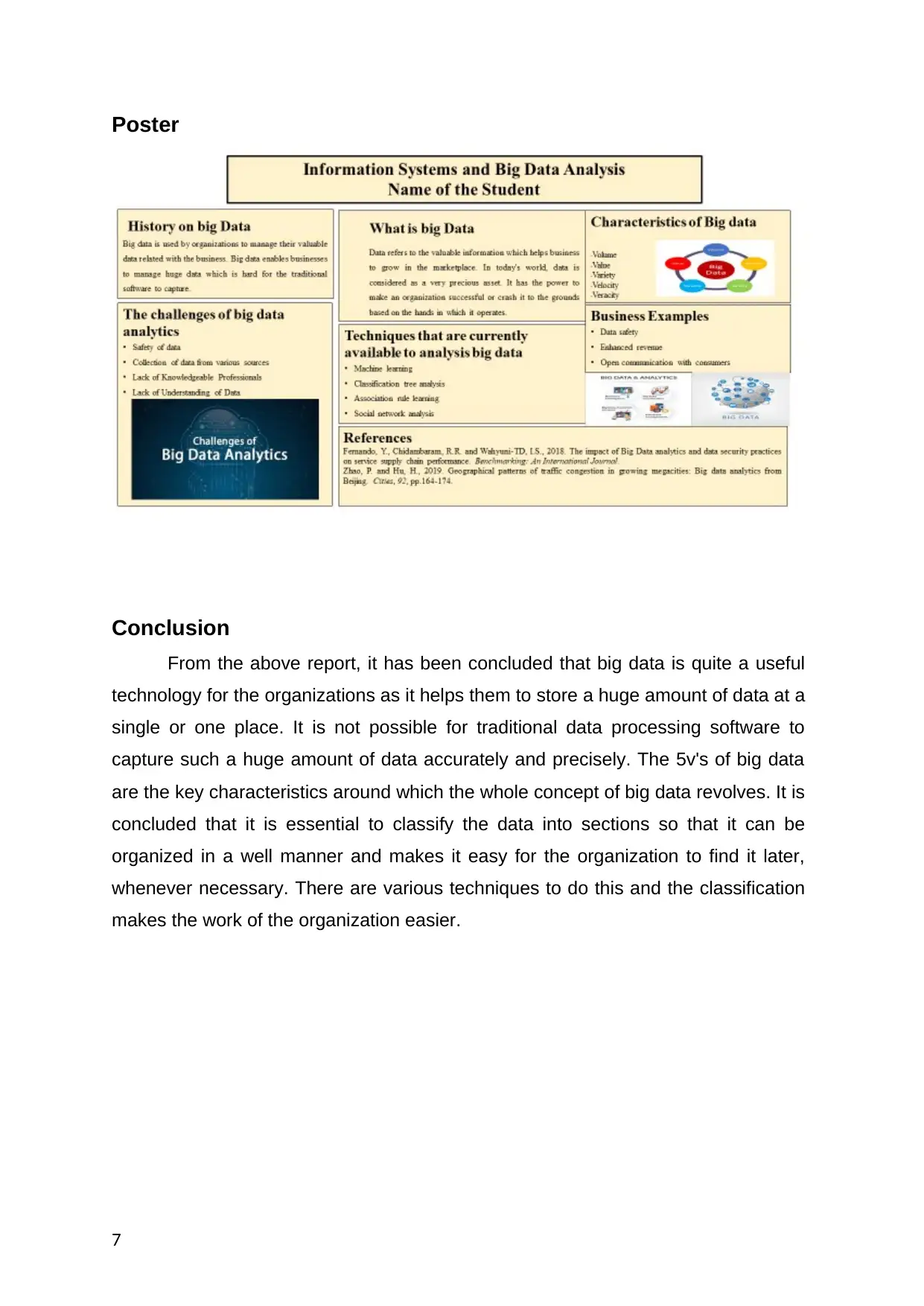
Poster
Conclusion
From the above report, it has been concluded that big data is quite a useful
technology for the organizations as it helps them to store a huge amount of data at a
single or one place. It is not possible for traditional data processing software to
capture such a huge amount of data accurately and precisely. The 5v's of big data
are the key characteristics around which the whole concept of big data revolves. It is
concluded that it is essential to classify the data into sections so that it can be
organized in a well manner and makes it easy for the organization to find it later,
whenever necessary. There are various techniques to do this and the classification
makes the work of the organization easier.
7
Conclusion
From the above report, it has been concluded that big data is quite a useful
technology for the organizations as it helps them to store a huge amount of data at a
single or one place. It is not possible for traditional data processing software to
capture such a huge amount of data accurately and precisely. The 5v's of big data
are the key characteristics around which the whole concept of big data revolves. It is
concluded that it is essential to classify the data into sections so that it can be
organized in a well manner and makes it easy for the organization to find it later,
whenever necessary. There are various techniques to do this and the classification
makes the work of the organization easier.
7
Paraphrase This Document
Need a fresh take? Get an instant paraphrase of this document with our AI Paraphraser
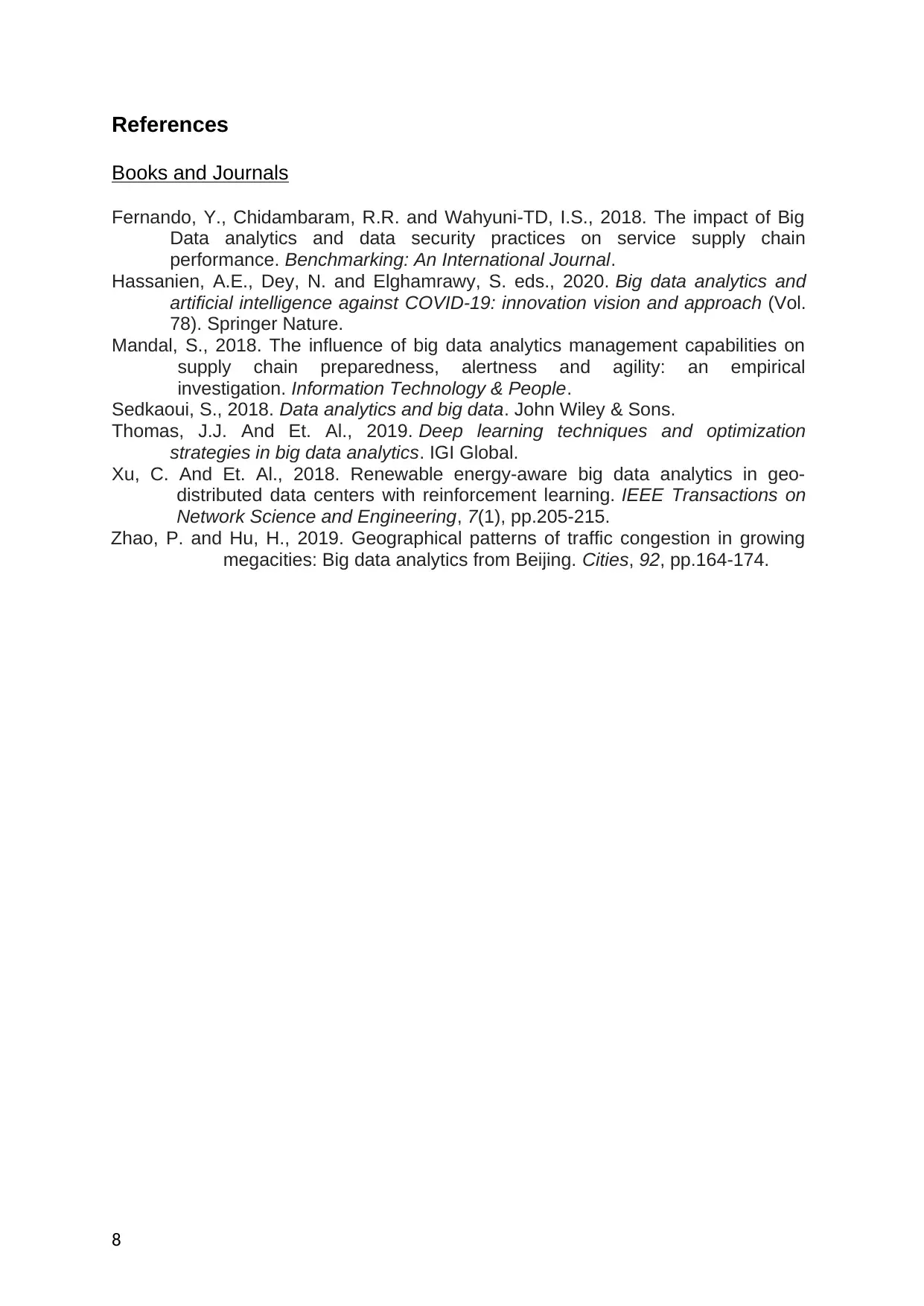
References
Books and Journals
Fernando, Y., Chidambaram, R.R. and Wahyuni-TD, I.S., 2018. The impact of Big
Data analytics and data security practices on service supply chain
performance. Benchmarking: An International Journal.
Hassanien, A.E., Dey, N. and Elghamrawy, S. eds., 2020. Big data analytics and
artificial intelligence against COVID-19: innovation vision and approach (Vol.
78). Springer Nature.
Mandal, S., 2018. The influence of big data analytics management capabilities on
supply chain preparedness, alertness and agility: an empirical
investigation. Information Technology & People.
Sedkaoui, S., 2018. Data analytics and big data. John Wiley & Sons.
Thomas, J.J. And Et. Al., 2019. Deep learning techniques and optimization
strategies in big data analytics. IGI Global.
Xu, C. And Et. Al., 2018. Renewable energy-aware big data analytics in geo-
distributed data centers with reinforcement learning. IEEE Transactions on
Network Science and Engineering, 7(1), pp.205-215.
Zhao, P. and Hu, H., 2019. Geographical patterns of traffic congestion in growing
megacities: Big data analytics from Beijing. Cities, 92, pp.164-174.
8
Books and Journals
Fernando, Y., Chidambaram, R.R. and Wahyuni-TD, I.S., 2018. The impact of Big
Data analytics and data security practices on service supply chain
performance. Benchmarking: An International Journal.
Hassanien, A.E., Dey, N. and Elghamrawy, S. eds., 2020. Big data analytics and
artificial intelligence against COVID-19: innovation vision and approach (Vol.
78). Springer Nature.
Mandal, S., 2018. The influence of big data analytics management capabilities on
supply chain preparedness, alertness and agility: an empirical
investigation. Information Technology & People.
Sedkaoui, S., 2018. Data analytics and big data. John Wiley & Sons.
Thomas, J.J. And Et. Al., 2019. Deep learning techniques and optimization
strategies in big data analytics. IGI Global.
Xu, C. And Et. Al., 2018. Renewable energy-aware big data analytics in geo-
distributed data centers with reinforcement learning. IEEE Transactions on
Network Science and Engineering, 7(1), pp.205-215.
Zhao, P. and Hu, H., 2019. Geographical patterns of traffic congestion in growing
megacities: Big data analytics from Beijing. Cities, 92, pp.164-174.
8
1 out of 8
Related Documents
Your All-in-One AI-Powered Toolkit for Academic Success.
+13062052269
info@desklib.com
Available 24*7 on WhatsApp / Email
![[object Object]](/_next/static/media/star-bottom.7253800d.svg)
Unlock your academic potential
Copyright © 2020–2025 A2Z Services. All Rights Reserved. Developed and managed by ZUCOL.

